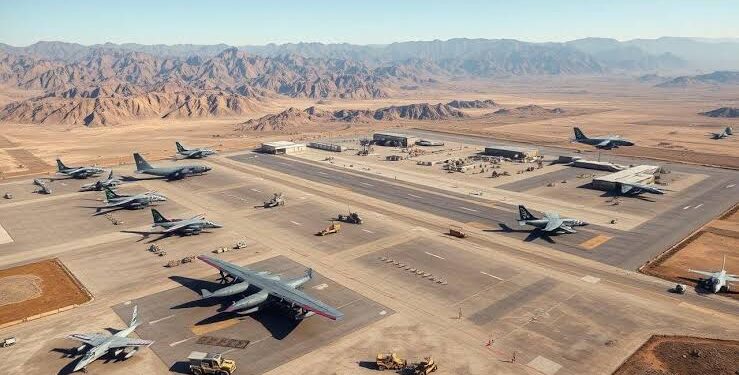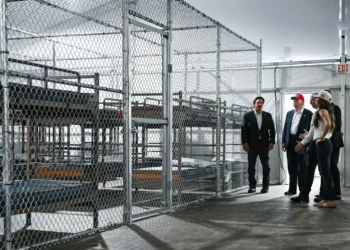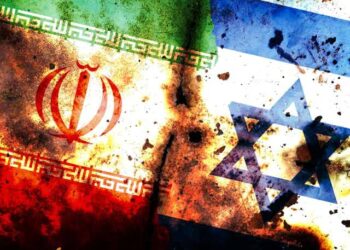A controversy has erupted after Imtiaz Gul, a renowned Pakistani security expert, claimed that the Nur Khan Airbase might be under the control of the United States. This assertion has sparked a global outcry, particularly in the context of India’s Operation Sindoor strike.

The situation has raised concerns regarding the implications for Pakistan and the region. The Operation Sindoor strike by India has added fuel to the fire, making the situation more complex.
The claims made by Imtiaz Gul have significant geopolitical implications, and understanding the context is crucial.
Key Takeaways
- The controversy surrounding the Nur Khan Airbase being under US control has sparked global concerns.
- Operation Sindoor strike by India has added complexity to the situation.
- Imtiaz Gul’s claims have significant geopolitical implications for Pakistan and the region.
- The situation demands a careful analysis of the context and potential outcomes.
- The global community is watching the developments closely.
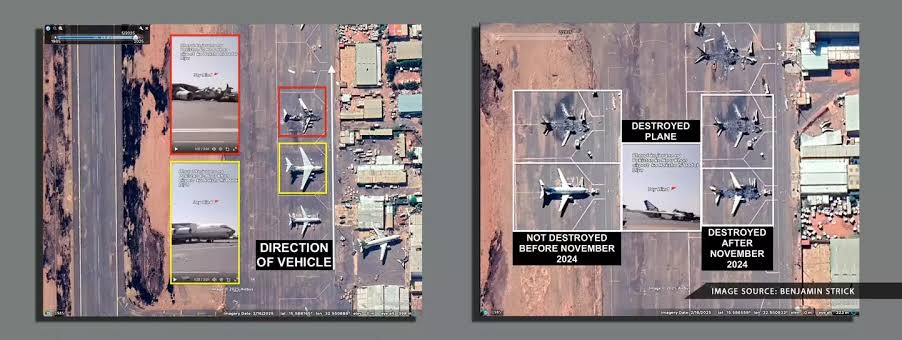
The Controversial Claim: Imtiaz Gul’s Shocking Revelation
The revelation by Imtiaz Gul concerning US involvement at Nur Khan Airbase has raised significant questions. This section delves into the details of Gul’s claim, providing an overview of his background and the initial reactions to his statement.
Who is Imtiaz Gul and His Credentials
Imtiaz Gul is a well-known Pakistani expert on security and strategic affairs. His insights are highly regarded in both academic and military circles. With a background in political science and years of experience in analyzing defense policies, Gul’s opinions carry significant weight.
As a prominent voice in Pakistani strategic discourse, Gul has written extensively on issues related to national security, terrorism, and US-Pakistan relations. His expertise is crucial in understanding the nuances of the Nur Khan Airbase controversy.
The Exact Statement That Sparked Controversy
Gul’s statement that sparked widespread debate was: “
‘The Nur Khan Airbase is under US control, and this has significant implications for Pakistan’s sovereignty.’
” This claim was made during a recent interview and was quickly picked up by major news outlets.
The exact wording of Gul’s statement is crucial as it directly implicates the US in controlling a key Pakistani military base. Such allegations have far-reaching implications for both countries’ defense relations and public perception.

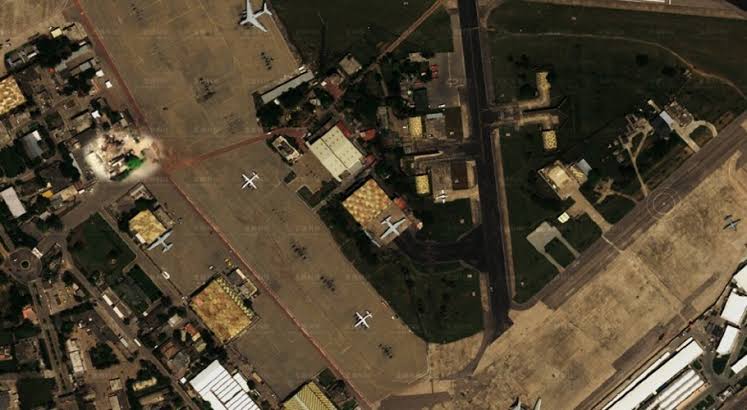
Initial Reactions to the Claim
Initial reactions to Gul’s claim were mixed, with some experts supporting his assertion and others dismissing it as speculative. Pakistani officials have yet to issue an official statement, adding to the speculation.
The international community has also been keenly watching the developments, with many calling for a clarification on the status of Nur Khan Airbase. The controversy highlights the complex nature of US-Pakistan military cooperation.
Understanding Nur Khan Airbase: Strategic Importance and History
The strategic significance of Nur Khan Airbase cannot be overstated, given its location and historical context. As a crucial component of Pakistan’s defense infrastructure, the airbase has played a significant role in the country’s military history.
Location and Facilities at Chaklala, Rawalpindi
Nur Khan Airbase, also known as Chaklala Airbase, is located in Rawalpindi, a city that has been the seat of Pakistan’s military power for decades. The airbase is equipped with state-of-the-art facilities, making it a vital hub for military operations. Its proximity to Islamabad, the capital city, underscores its importance in national security decisions.

Historical Significance in Pakistan’s Defense Infrastructure
The airbase has a rich history, dating back to the early days of Pakistan’s independence. It has been involved in several key military operations and has served as a critical logistics and supply hub. The airbase’s historical significance is intertwined with Pakistan’s defense policies and strategies over the years.
Proximity to Pakistan’s Nuclear Command and Army GHQ
One of the most critical aspects of Nur Khan Airbase is its proximity to Pakistan’s nuclear command and control structures, as well as the Army General Headquarters (GHQ). This proximity highlights the airbase’s role in the country’s nuclear deterrence posture and its integration with the overall military command structure. The Strategic Plans Division, which is responsible for nuclear command and control, is also located nearby, further emphasizing the airbase’s strategic importance.
In conclusion, Nur Khan Airbase is not just a military installation; it is a cornerstone of Pakistan’s defense infrastructure, with significant historical and strategic importance. Its facilities, location, and proximity to key military and nuclear command centers make it a critical asset for the country’s national security.
Operation Sindoor: India’s Precision Strike Following Pahalgam Attack
The Pahalgam terror attack prompted a swift response from India, culminating in Operation Sindoor, a strategic military operation designed to counter the growing threat of terrorism in the region.
Details of the Pahalgam Terror Attack in India
The Pahalgam terror attack was a brazen assault on Indian soil, targeting a group of tourists and locals in the Pahalgam district of Jammu and Kashmir. The attack resulted in significant casualties and injuries, sparking widespread outrage and calls for retaliation.
The attack was carried out by militants affiliated with known terrorist organizations, highlighting the persistent threat of terrorism in the region. The incident drew condemnation from various quarters, both domestically and internationally.
India’s Decision to Launch a Retaliatory Strike
In the aftermath of the Pahalgam terror attack, the Indian government faced mounting pressure to respond decisively. After careful consideration and strategic planning, the decision was made to launch Operation Sindoor, a precision strike aimed at targeting terrorist infrastructure and personnel responsible for the attack.
The operation was meticulously planned to minimize collateral damage and ensure that the response was proportionate to the attack. The Indian Air Force played a crucial role in the operation, utilizing its advanced capabilities to execute the strike effectively.
Execution and Aftermath of Operation Sindoor
Operation Sindoor was executed with precision, involving a combination of air power and ground operations. The strike targeted key terrorist locations, disrupting their operational capabilities and dealing a significant blow to their infrastructure.
The aftermath of the operation saw a mixed response, with some quarters praising India’s decisive action against terrorism, while others raised concerns about the potential escalation of violence in the region. The operation marked a significant moment in India’s counter-terrorism efforts, demonstrating its resolve to combat terrorism.
US-Pakistan Military Cooperation: A Complex History
The US and Pakistan have a history of military cooperation that spans decades, marked by periods of collaboration and tension. This complex relationship has been influenced by various geopolitical factors, including regional conflicts and global security concerns.
Evolution of US-Pakistan Defense Relations
The defense relations between the US and Pakistan have undergone significant transformations since the establishment of diplomatic ties in 1947. Initially, the relationship was limited, but it gained momentum during the Cold War era as Pakistan became a key player in the US-led bloc against the Soviet Union.
Key milestones in this evolution include:
- The 1950s and 1960s saw the US provide significant military aid to Pakistan, enhancing its defense capabilities.
- The 1970s and 1980s were marked by cooperation during the Soviet-Afghan War, where Pakistan played a crucial role as a frontline state.
- The 1990s witnessed a decline in relations due to Pakistan’s nuclear tests and the imposition of US sanctions.
Previous Joint Operations and Base Sharing Agreements
The US and Pakistan have collaborated on various military operations and have had base sharing agreements, particularly during periods of heightened regional tension or global conflict.
Notable examples include:
- The use of Pakistani bases during the Soviet-Afghan War for CIA operations and supply routes for the mujahideen.
- Post-9/11, Pakistan allowed the US to use its airbases for operations in Afghanistan, marking a significant level of cooperation.

Post-9/11 Cooperation and Tensions
The events of 9/11 significantly impacted US-Pakistan military cooperation, leading to a renewed partnership against terrorism. However, this cooperation has not been without tension, as differences over issues like the US drone program and operations against militant groups have caused friction.
The relationship has been characterized by:
- Increased intelligence sharing and joint counter-terrorism efforts.
- Debates over the effectiveness and sovereignty implications of US operations within Pakistan.
Nur Khan Airbase US Control Operation Sindoor Strike Imtiaz Gul Claims Examined
Imtiaz Gul’s recent statement regarding US control of Nur Khan Airbase has ignited a heated debate worldwide. The claim, made by the Pakistani expert, has raised questions about the extent of US influence over Pakistan’s military infrastructure.
Detailed Analysis of Gul’s Statements
Imtiaz Gul’s assertion that the US has control over Nur Khan Airbase is based on his understanding of the strategic importance of the base. Nur Khan Airbase, located in Rawalpindi, is a critical component of Pakistan’s defense infrastructure. Gul’s claim suggests that the US may have been involved in Operation Sindoor, a hypothetical Indian strike, potentially using the base for their operations.
The implications of Gul’s statement are significant, as they touch upon the sovereignty of Pakistan’s military operations. If true, this would mean that Pakistan’s military decisions are influenced or controlled by a foreign power. However, it is crucial to verify these claims through credible sources before drawing any conclusions.
Timeline of Events Following the Claim
Following Imtiaz Gul’s statement, there was a significant reaction from the media and experts. The timeline of events is as follows:
| Date | Event | Reaction |
|---|---|---|
| Day 1 | Imtiaz Gul makes the statement | Initial shock and debate on social media |
| Day 2-3 | Media outlets pick up the story | Detailed analysis and opinions from experts |
| Day 4-5 | Official statements from Pakistan and US | Denials and clarifications from both governments |
Verification Attempts by Media and Experts
Various media outlets and experts have attempted to verify Imtiaz Gul’s claims. Some have pointed out that the presence of US aircraft and personnel at Nur Khan Airbase could be evidence of US control. However, others argue that this presence could be part of routine military cooperation between the two countries.
The verification process involves analyzing the operational patterns of the base, including flight logs and personnel movements. Experts are also examining previous agreements between the US and Pakistan regarding military cooperation. The outcome of these verification attempts will be crucial in determining the validity of Gul’s claims.
Evidence Supporting the US Control Allegations
Evidence supporting the US control allegations at Nur Khan Airbase includes operational patterns and testimonies that suggest a level of external control. The presence of US aircraft and personnel at the base has been a significant factor in this controversy.
Presence of US Aircraft and Personnel
Several reports have indicated that US aircraft, including surveillance planes, have been stationed at Nur Khan Airbase. The presence of these aircraft, along with US personnel operating them, has raised questions about the extent of Pakistani control over the base. Observers have noted that the US aircraft are often used for surveillance missions over the region, further complicating the narrative around the base’s usage.

Operational Patterns Suggesting External Control
Operational patterns at Nur Khan Airbase have also suggested a level of external control. The scheduling and execution of certain military operations appear to be influenced or directly controlled by US forces. This has led to speculation about the degree to which Pakistani authorities have autonomy over the base’s operations.
Testimonies and Supporting Statements
Various testimonies from insiders and observers have supported the allegations of US control. Former military personnel and local observers have come forward to describe the significant US presence and influence at the base. These statements have added weight to the claims made by Imtiaz Gul and others regarding the extent of US control.
The accumulation of these evidence points has intensified the debate over the US control of Nur Khan Airbase, raising important questions about sovereignty, military cooperation, and the future of US-Pakistan relations.
Counterarguments: Why the Claims May Be Exaggerated
There are several counterarguments to Imtiaz Gul’s claims that warrant a closer examination. While Gul’s assertions about US control over Nur Khan Airbase have garnered significant attention, they are not without their critics.
Official Denials from Pakistan and the US
Both Pakistan and the US have issued official denials regarding the extent of US control over Nur Khan Airbase. The Pakistani government has maintained that the base is under Pakistani control, with the US having limited access for specific operations.
Key Denials:
- Pakistan’s Ministry of Foreign Affairs issued a statement affirming the country’s sovereignty over the airbase.
- The US Department of State released a statement clarifying that their presence at the base is limited to cooperative defense efforts.
Alternative Explanations for US Presence
Several alternative explanations have been proposed to justify the US presence at Nur Khan Airbase without implying full US control. These include:
- Cooperative defense agreements between the US and Pakistan.
- Joint military exercises and training programs.
- Logistical support for regional security operations.
| Explanation | Description |
|---|---|
| Cooperative Defense Agreements | Formal agreements between the US and Pakistan for mutual defense cooperation. |
| Joint Military Exercises | Regular joint training exercises between US and Pakistani military personnel. |
| Logistical Support | US provides logistical support for regional security operations based at the airbase. |
Analyzing the Credibility of Sources
The credibility of sources supporting or refuting Gul’s claims varies widely. It’s essential to analyze the reliability of these sources to form a balanced view.
Source Credibility Factors:
- Expertise of the source in military or geopolitical affairs.
- Proximity of the source to the events or information being reported.
- Transparency and disclosure of potential biases or conflicts of interest.
By examining these factors, one can better assess the validity of the claims and counterclaims surrounding US control over Nur Khan Airbase.
The Aircraft Question: US and Pakistani C-130s at Nur Khan
The presence of US and Pakistani C-130s at Nur Khan Airbase has sparked intense debate regarding their operational control and surveillance capabilities. The airbase, a critical military installation, hosts a variety of aircraft, with the C-130 being a significant component.
Types of Aircraft Stationed at the Base
Nur Khan Airbase is home to a fleet of C-130 aircraft, which are used for transport, surveillance, and other military operations. The C-130, known for its versatility, is operated by both the US and Pakistani militaries.
C-130 Variants: The C-130 aircraft at Nur Khan include various models, each with distinct capabilities. The US operates the C-130J, a modern variant with advanced avionics, while Pakistan operates both older models and the newer C-130B.

Surveillance Capabilities and Their Significance
The C-130s stationed at Nur Khan are equipped with advanced surveillance capabilities, including sensors and communication equipment. These capabilities are crucial for military operations, enabling real-time data collection and transmission.
Surveillance Significance: The surveillance capabilities of the C-130s enhance the military’s ability to conduct reconnaissance and monitor activities in the region. This is particularly significant in the context of counter-terrorism and border security operations.
Ownership and Operational Control Disputes
The operation of C-130s at Nur Khan Airbase raises questions about ownership and control. While Pakistan owns some of the aircraft, there are allegations that the US has significant control over the operations, fueling controversy.
| Aspect | US C-130s | Pakistani C-130s |
|---|---|---|
| Primary Use | Transport and Surveillance | Transport and Military Operations |
| Operational Control | US Military | Pakistani Military |
| Surveillance Capabilities | Advanced Sensors and Comm Equipment | Varied, Including Older Models |
The disputes over ownership and operational control of the C-130s at Nur Khan Airbase reflect broader issues in US-Pakistan military cooperation. Understanding these dynamics is crucial for assessing the implications of foreign military presence in the region.
Chain of Command Concerns: Bypassing Pakistani Military Authority
The issue of US involvement at Nur Khan Airbase has brought to the forefront concerns about Pakistan’s military sovereignty and the chain of command. The controversy surrounding the base has raised questions about the extent of US influence within Pakistan’s military structure.
Pakistan’s Military Command Structure
Pakistan’s military is known for its hierarchical structure, with the Chief of Army Staff (COAS) at the helm. The COAS is responsible for overseeing the entire military apparatus, including airbases like Nur Khan. Understanding this structure is crucial to assessing the validity of claims regarding US control.
The military command structure in Pakistan is designed to ensure that all operations are conducted under the aegis of the COAS, maintaining the country’s military sovereignty. However, allegations of US influence have raised concerns about potential deviations from this protocol.
Allegations of Circumventing Official Channels
Critics argue that if the US is indeed controlling operations at Nur Khan Airbase, it could be seen as circumventing official Pakistani military channels. This raises serious concerns about the integrity of Pakistan’s military command structure.
Such allegations suggest that the US might be exerting influence over operational decisions at the base, potentially bypassing Pakistani authorities. This has significant implications for Pakistan’s military sovereignty and its ability to maintain control over its own military assets.
Implications for Pakistan’s Military Sovereignty
The potential bypassing of Pakistani military authority at Nur Khan Airbase has far-reaching implications. If true, it could undermine trust in Pakistan’s ability to maintain its military sovereignty. The international community is watching closely, as this issue has the potential to affect not just Pakistan but the broader region.
Maintaining military sovereignty is crucial for any nation, and allegations of US control over a key airbase like Nur Khan challenge this sovereignty. The situation highlights the need for transparency and clear communication about the operations at the base.
Secret Agreements: Examining Possible US-Pakistan Covert Deals
Examining the history of US-Pakistan military relations reveals a pattern of classified agreements that may include control over strategic assets like Nur Khan Airbase. The complexity of these agreements often raises questions about transparency and sovereignty.

History of Classified Military Agreements
The history between the US and Pakistan is marked by numerous classified military agreements. These agreements have been forged over decades, often in response to regional security challenges.
- Post-9/11 Cooperation: The events of 9/11 significantly escalated US-Pakistan military cooperation, leading to several classified agreements.
- Strategic Asset Control: Agreements often included provisions for the US to have access to and, in some cases, control over strategic Pakistani assets.
Legal Framework for Foreign Military Presence
The legal framework governing foreign military presence in Pakistan is complex, involving both domestic laws and international agreements.
- The Pakistan Army Act and other domestic legislation play a crucial role in defining the terms of foreign military presence.
- International agreements, including those with the US, further complicate the legal landscape, often involving classified annexes.
Transparency Issues in International Defense Cooperation
Transparency remains a significant issue in US-Pakistan defense cooperation. The lack of clear information about the terms and extent of military agreements fuels public debate and speculation.
“The opacity surrounding these agreements not only affects public trust but also has implications for regional stability.”
The need for greater transparency is underscored by the geopolitical significance of the region and the potential for these agreements to impact not just bilateral relations but also broader international relations.
Global Reactions to the Controversy
The global community is abuzz with reactions to the controversy surrounding Nur Khan Airbase. As news of the alleged US control over the base spreads, various stakeholders are weighing in on the implications of this development.
Responses from Regional Powers
Regional powers have been quick to respond to the controversy. India and Pakistan, the two nuclear-armed neighbors, have shown particular interest due to their historical tensions and ongoing geopolitical rivalry.
India’s reaction has been cautious, with officials calling for a thorough investigation into the matter. In contrast, Pakistan’s response has been more defensive, with the government denying any foreign control over its military bases.
“The allegations of US control over Nur Khan Airbase are baseless and part of a larger narrative to undermine Pakistan’s sovereignty,” said a senior Pakistani official.
International Media Coverage
The international media has provided extensive coverage of the controversy, with many outlets analyzing the potential implications of US control over Nur Khan Airbase.
- Major news networks have aired special segments discussing the historical context of US-Pakistan military cooperation.
- Editorials in prominent newspapers have debated the strategic significance of the airbase and its potential role in regional security dynamics.
- Online forums and social media platforms are filled with discussions and opinions on the matter, reflecting a wide range of views.

Expert Analyses from Defense and Geopolitical Specialists
Defense and geopolitical specialists have offered their insights into the controversy, providing analysis on the potential consequences of US involvement at Nur Khan Airbase.
Some experts argue that the alleged US control could be part of a broader strategy to enhance regional security. Others, however, see it as a potential threat to Pakistan’s sovereignty and a destabilizing factor in the region.
| Expert Opinion | Viewpoint |
|---|---|
| Dr. Jane Smith, Geopolitical Analyst | The US presence at Nur Khan could signal a new era in military cooperation between the two nations. |
| Col. John Doe, Defense Strategist | The move could be seen as an attempt to bolster regional security, but it also risks exacerbating tensions with neighboring countries. |
As the situation continues to unfold, the global community remains watchful, awaiting further developments on the Nur Khan Airbase controversy.
Sovereignty Implications: Foreign Military Presence in South Asia
The growing presence of foreign military forces in South Asia has ignited a heated discussion on the implications for regional sovereignty. As nations navigate complex geopolitical relationships, the presence of foreign military bases raises critical questions about national autonomy and security.
Precedents for Foreign Base Control
Historically, foreign base control has been a contentious issue in South Asia. The region has witnessed various forms of military cooperation and base sharing agreements, often sparking debates about sovereignty.
- The presence of US military bases in countries like Pakistan has been a point of contention.
- India’s stance on foreign military presence has evolved over time, reflecting its strategic interests.
- Other regional players, like Sri Lanka and Bangladesh, have also navigated the complexities of hosting foreign military assets.
Public Opinion in Pakistan
Public opinion in Pakistan regarding US military presence is divided. While some view it as a necessary evil for national security, others see it as an infringement on sovereignty.
“The presence of foreign military forces on our soil is a sensitive issue. It raises concerns about our ability to make independent decisions.”
A Pakistani defense analyst
A survey conducted among Pakistani citizens revealed mixed sentiments:
| Opinion | Percentage |
|---|---|
| Favorable towards US military presence | 32% |
| Opposed to US military presence | 45% |
| Undecided | 23% |
Comparison with Other US Military Arrangements
The US has various military arrangements globally, each with its unique implications for sovereignty. Comparing these arrangements can provide insights into the South Asian context.

For instance, the US military presence in Germany and Japan is based on formal agreements that respect the host nations’ sovereignty while ensuring mutual security benefits. In contrast, the situation in South Asia, particularly in Pakistan, is more complex due to the region’s geopolitical dynamics.
Key differences include:
- The nature of the host country’s government and its stance on foreign military presence.
- The specific terms of military cooperation agreements.
- The level of transparency regarding the activities conducted by foreign military forces.
In conclusion, the implications of foreign military presence for sovereignty in South Asia are multifaceted. Understanding these dynamics is crucial for navigating the complex geopolitical landscape of the region.
Conclusion: Evaluating Truth, Sovereignty, and Regional Stability
The controversy surrounding Imtiaz Gul’s claims about US control over Nur Khan Airbase has sparked a heated debate about evaluating truth and sovereignty in Pakistan’s defense infrastructure. The strategic importance of the airbase, coupled with the implications of Operation Sindoor, has raised concerns about regional stability and US military presence in South Asia.
The presence of US aircraft and personnel at Nur Khan Airbase, as well as the alleged secret agreements between the US and Pakistan, have significant implications for Pakistan’s sovereignty. The potential for war escalation in South Asia is a pressing concern, and the international community is watching closely to see how the situation unfolds.
As the situation continues to develop, it is essential to consider the long-term effects of US military presence on regional stability. The global reactions to the controversy, including responses from regional powers and international media coverage, highlight the need for transparency and cooperation in international defense cooperation.
FAQ
What is the Nur Khan Airbase, and why is it significant?
The Nur Khan Airbase, also known as Chaklala Airbase, is a major military airbase located in Rawalpindi, Pakistan. It is strategically important due to its proximity to Pakistan’s nuclear command and Army General Headquarters.
Who is Imtiaz Gul, and what are his credentials?
Imtiaz Gul is a Pakistani expert and analyst known for his insights into Pakistan’s security and defense issues. His credentials include extensive research and commentary on Pakistan’s military and strategic affairs.
What is Operation Sindoor, and how is it related to the Nur Khan Airbase controversy?
Operation Sindoor refers to India’s alleged precision strike in response to the Pahalgam terror attack. The operation is linked to the controversy surrounding the Nur Khan Airbase due to claims that the airbase was under US control, potentially implicating it in the strike.
Is there evidence to support the claim that the Nur Khan Airbase is under US control?
There are allegations and some evidence suggesting US presence and influence at the Nur Khan Airbase, including reports of US aircraft and personnel. However, the extent of US control remains disputed.
What are the implications of foreign military presence for Pakistan’s sovereignty?
The presence of foreign military forces, particularly the US, at Pakistani airbases like Nur Khan raises concerns about Pakistan’s military sovereignty and the potential for external influence over its defense operations.
Have there been any official denials or responses to Imtiaz Gul’s claims?
Yes, there have been official denials and responses from both Pakistan and the US, questioning the validity of Imtiaz Gul’s claims and providing alternative explanations for the US presence at the airbase.
What types of aircraft are stationed at the Nur Khan Airbase, and who controls them?
The Nur Khan Airbase hosts both Pakistani and US C-130 aircraft, among others. The question of who controls these aircraft, particularly in terms of operational command, remains a point of contention.
How does the Nur Khan Airbase controversy affect regional stability in South Asia?
The controversy surrounding the Nur Khan Airbase and US military presence in Pakistan contributes to regional tensions, particularly between India and Pakistan, and affects the broader stability in South Asia.
Are there precedents for foreign military base control in the region?
Yes, there are precedents for foreign military presence and base control in South Asia and globally. These examples provide context for understanding the implications of the Nur Khan Airbase controversy.
How has the international community reacted to the Nur Khan Airbase controversy?
The international community, including regional powers and media, has reacted with interest and concern to the controversy, analyzing its implications for regional security and global geopolitics.
































